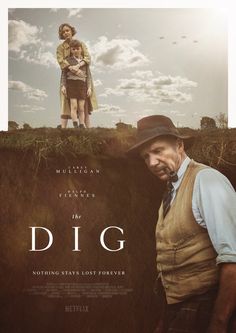The Dig (2021)
- phanthuthuy
- November 20, 2024

The Dig (2021), directed by Simon Stone, is a beautifully crafted historical drama that explores themes of discovery, legacy, and the fleeting nature of life. Based on true events, the film tells the story of the Sutton Hoo excavation, one of the most significant archaeological finds in British history, while delving into the deeply human stories of those involved.

Set in 1939 on the eve of World War II, the film follows Edith Pretty (Carey Mulligan), a wealthy widow who hires local excavator Basil Brown (Ralph Fiennes) to investigate ancient burial mounds on her estate in Suffolk. As they unearth a buried Anglo-Saxon ship and its treasures, the dig becomes a symbol of history’s enduring presence amidst the uncertainty of the impending war. Alongside the excavation, the film weaves personal narratives of ambition, loss, and connection among its characters.

Simon Stone’s direction emphasizes the quiet beauty of both the natural landscape and the human relationships at the heart of the story. The film balances the grandeur of its historical subject with the intimacy of its characters’ personal struggles, creating a narrative that feels both epic and profoundly personal. Stone’s ability to juxtapose the fragility of human life with the timelessness of history adds emotional weight to the story.
Ralph Fiennes delivers a standout performance as Basil Brown, portraying him as a humble yet determined man whose dedication to his craft often goes unrecognized. Carey Mulligan brings depth and quiet strength to Edith Pretty, a woman grappling with her own mortality while seeking to leave a legacy. The supporting cast, including Lily James as ambitious archaeologist Peggy Piggott and Johnny Flynn as Rory Lomax, enriches the story with their intertwined personal arcs.

Visually, The Dig is stunning. Cinematographer Mike Eley captures the rolling Suffolk countryside in all its earthy beauty, using natural light and expansive shots to reflect the film’s themes of connection and discovery. The muted, atmospheric palette underscores the introspective tone of the story, while the excavation scenes bring a tactile authenticity to the historical drama.
Stephen Warbeck’s gentle score adds an emotional resonance, subtly enhancing the film’s themes of time, memory, and impermanence. The music mirrors the reflective nature of the narrative, blending seamlessly with the film’s visual and emotional rhythms.

At its core, The Dig is about more than just archaeology; it is a meditation on legacy, human connection, and the ways in which we leave our mark on the world. It captures the profound sense of wonder that comes from uncovering the past while reminding viewers of the impermanence of life.
For those who appreciate historical dramas that combine quiet introspection with sweeping emotion, The Dig is a must-watch. Unearth a story of discovery, resilience, and the enduring power of history in this beautifully realized film.











